HONDA CIVIC COUPE 2014 9.G CNG Owner's Guide
Manufacturer: HONDA, Model Year: 2014, Model line: CIVIC COUPE, Model: HONDA CIVIC COUPE 2014 9.GPages: 46, PDF Size: 3.84 MB
Page 31 of 46

30
Handling the Unexpected
If a Tire Goes Flat Temporarily Repairing a Flat Tire
1. Remove the trunk floor lid.
2. Take the kit out of the case.
Place the kit face up, on flat ground
near the flat tire, and away from traffic.
Do not place the kit on its side.
Getting Ready to Temporarily Repair the Flat Tire
When making a temporary repair, carefully read the
instruction manual provided with the kit.
In cold temperatures, the sealant may not flow
easily. In this situation, warm it up for five minutes
before using.
2014 Civic CNG
Page 32 of 46

31Continued
Handling the Unexpected
If a Tire Goes Flat Temporarily Repairing a Flat Tire
Injecting Sealant and Air
1. Remove the valve cap from the tire valve
stem.
2. Remove the sealant /air hose from the
packaging.
3. Attach the sealant /air hose onto the tire
valve stem. Screw it until it is tight.
Valve Stem
Valve Cap
Sealant /Air Hose
Sealant /Air Hose
Valve Stem
Injecting Sealant and Air
WARNING
Tire sealant contains substances that are
harmful and can be fatal if swallowed.
If accidentally swallowed, do not induce
vomiting. Drink plenty of water and get
medical attention immediately.
For skin or eye contact, flush with cool
water and get medical attention if
necessary.
In cold temperatures, the sealant may not flow
easily. In this situation, warm it up for five minutes
before using.
The sealant can permanently stain clothing and
other materials. Be careful during handling and
wipe away any spills immediately.
2014 Civic CNG
Page 33 of 46
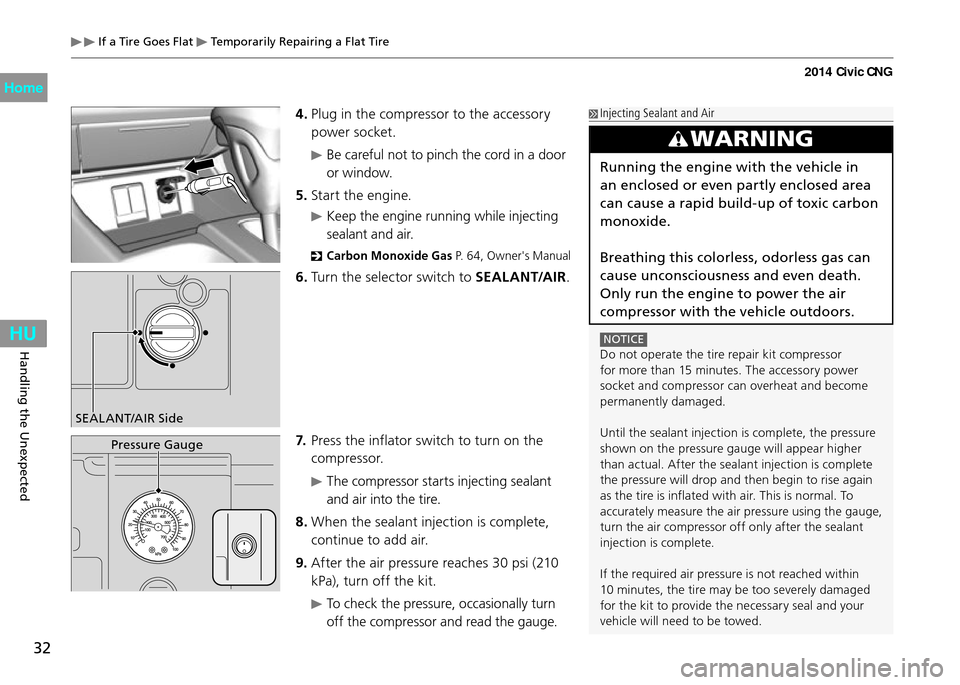
32
Handling the Unexpected
If a Tire Goes Flat Temporarily Repairing a Flat Tire
4. Plug in the compressor to the accessory
power socket.
Be careful not to pinch the cord in a door
or window.
5. Start the engine.
Keep the engine running while injecting
sealant and air.
Carbon Monoxide Ga s
P. 64, Owner's Manual
6. Turn the selector switch to SEALANT/AIR .
7. Press the inflator switch to turn on the
compressor.
The compressor starts injecting sealant
and air into the tire.
8. When the sealant injection is complete,
continue to add air.
9. After the air pressure reaches 30 psi (210
kPa), turn off the kit.
To check the pressure, occasionally turn
off the compressor and read the gauge.
Injecting Sealant and Air
SEAL ANT/AIR Side
Pressure Gauge
WARNING
Running the engine with the vehicle in
an enclosed or even partly enclosed area
can cause a rapid build-up of toxic carbon
monoxide.
Breathing this colorless, odorless gas can
cause unconsciousness and even death.
Only run the engine to power the air
compressor with the vehicle outdoors.
NOTICE Do not operate the tire repair kit compressor
for more than 15 minutes. The accessory power
socket and compressor can overheat and become
permanently damaged.
Until the sealant injection is complete, the pressure
shown on the pressure gauge will appear higher
than actual. After the sealant injection is complete
the pressure will drop and then begin to rise again
as the tire is inflated with air. This is normal. To
accurately measure the air pressure using the gauge,
turn the air compressor off only after the sealant
injection is complete.
If the required air pressure is not reached within
10 minutes, the tire may be too severely damaged
for the kit to provide the necessary seal and your
vehicle will need to be towed.
2014 Civic CNG
Page 34 of 46
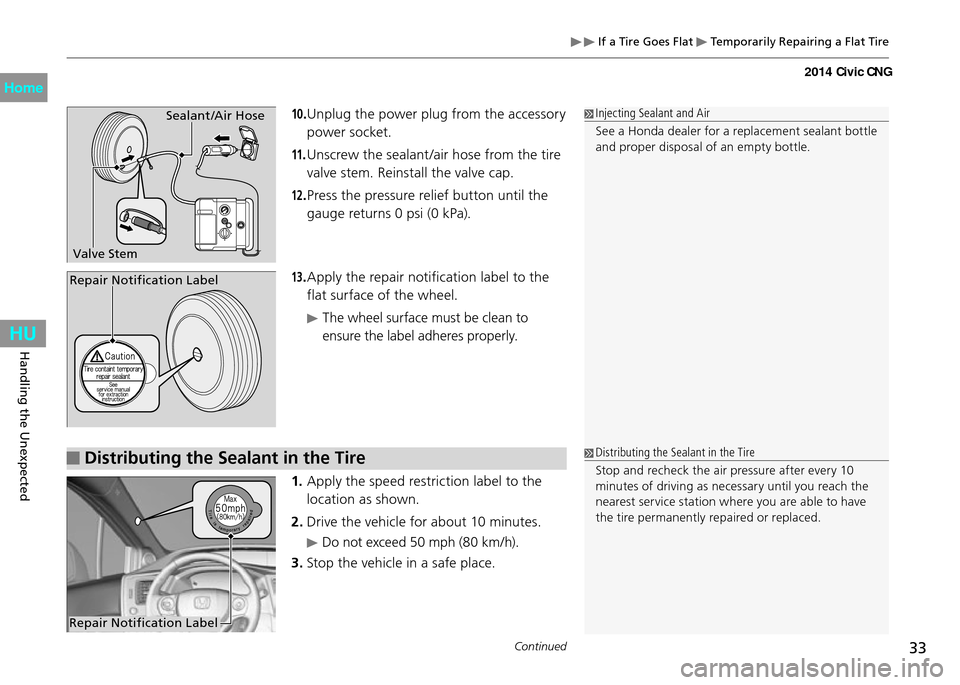
33Continued
Handling the Unexpected
If a Tire Goes Flat Temporarily Repairing a Flat Tire
10. Unplug the power plug from the accessory
power socket.
11. Unscrew the sealant /air hose from the tire
valve stem. Reinstall the valve cap.
12. Press the pressure relief button until the
gauge returns 0 psi (0 kPa).
13. Apply the repair notification label to the
flat surface of the wheel.
The wheel surface must be clean to
ensure the label adheres properly.
Repair Notification LabelValve Stem Sealant /Air Hose
Distributing the Sealant in the Tire
Repair Notification Label
1.
Apply the speed restriction label to the
location as shown.
2. Drive the vehicle for about 10 minutes.
Do not exceed 50 mph (80 km/h).
3. Stop the vehicle in a safe place.
Injecting Sealant and Air
See a Honda dealer for a replacement sealant bottle
and proper disposal of an empty bottle.
Distributing the Sealant in the Tire
Stop and recheck the air pressure after every 10
minutes of driving as necessary until you reach the
nearest service station where you are able to have
the tire permanently repaired or replaced.
2014 Civic CNG
Page 35 of 46
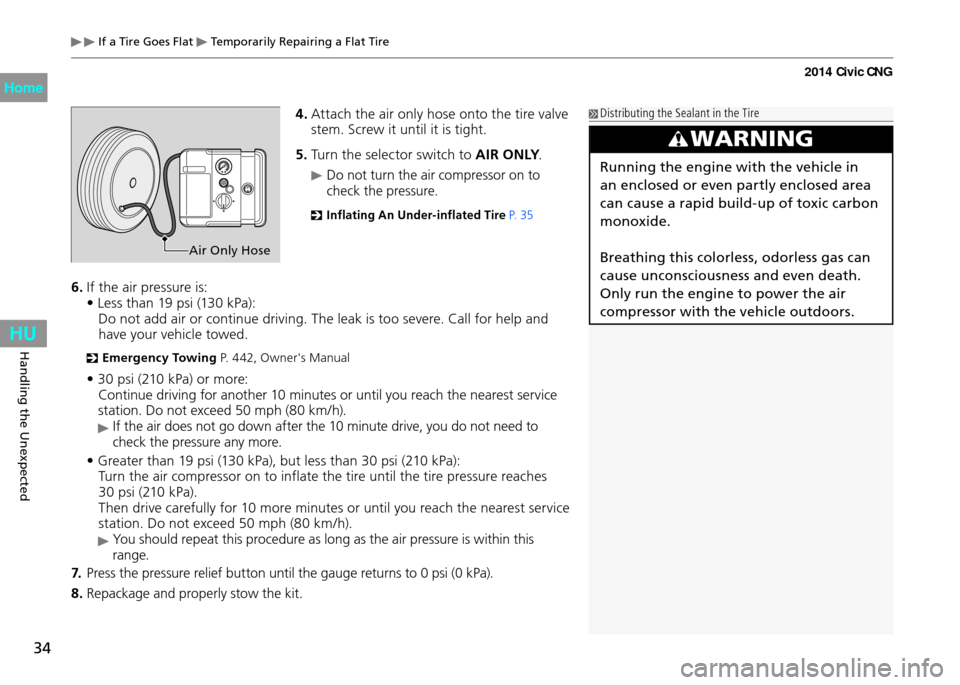
34
Handling the Unexpected
If a Tire Goes Flat Temporarily Repairing a Flat Tire
4. Attach the air only hose onto the tire valve
stem. Screw it until it is tight.
5. Turn the selector switch to AIR ONLY .
Do not turn the air compressor on to
check the pressure.
Inflating An Under-inflated Tire
P. 35
Air Only Hose
Distributing the Sealant in the Tire
WARNING
Running the engine with the vehicle in
an enclosed or even partly enclosed area
can cause a rapid build-up of toxic carbon
monoxide.
Breathing this colorless, odorless gas can
cause unconsciousness and even death.
Only run the engine to power the air
compressor with the vehicle outdoors.
6. If the air pressure is:
• Less than 19 psi (130 kPa):
Do not add air or continue driving. The leak is too severe. Call for help and
have your vehicle towed.
Emergency Towin g
P. 442, Owner's Manual
• 30 psi (210 kPa) or more:
Continue driving for another 10 minutes or until you reach the nearest service
station. Do not exceed 50 mph (80 km/h).
If the air does not go down after the 10 minute drive, you do not need to
check the pressure any more.
• Greater than 19 psi (130 kPa), but less than 30 psi (210 kPa):
Turn the air compressor on to inflate the tire until the tire pressure reaches
30 psi (210 kPa).
Then drive carefully for 10 more minutes or until you reach the nearest service
station. Do not exceed 50 mph (80 km/h).
You should repeat this procedure as long as the air pressure is within this
range.
7. Press the pressure relief button until the gauge returns to 0 psi (0 kPa).
8. Repackage and properly stow the kit.
2014 Civic CNG
Page 36 of 46
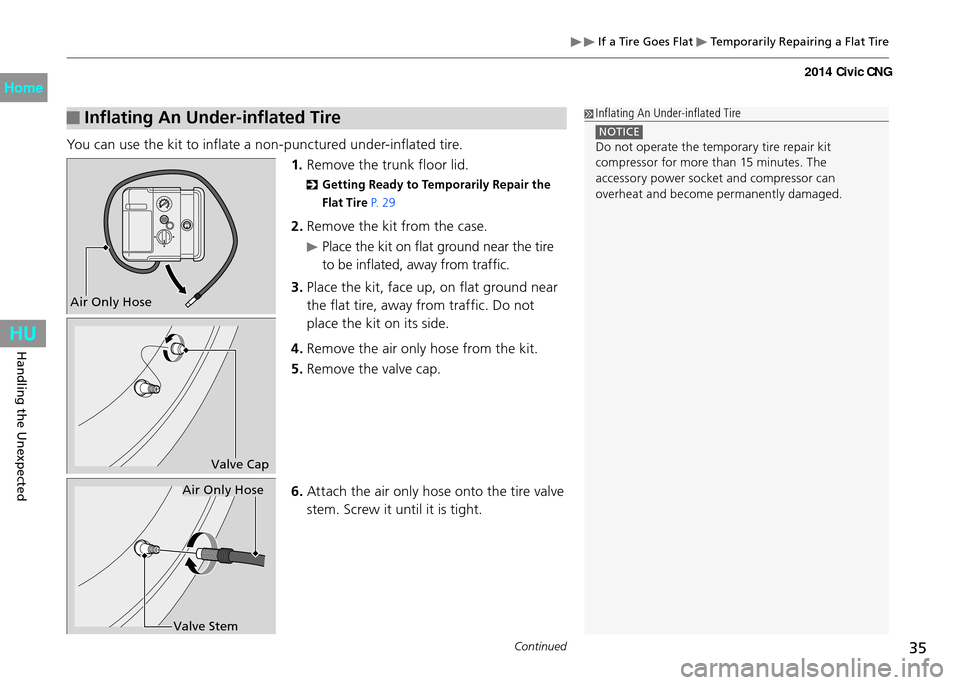
35Continued
Handling the Unexpected
If a Tire Goes Flat Temporarily Repairing a Flat Tire
Inflating An Under-inflated Tire
You can use the kit to inflate a non-punctured under-inflated tire.
1. Remove the trunk floor lid.
Getting Ready to Temporarily Repair the
Flat Tir e P. 29
2. Remove the kit from the case.
Place the kit on flat ground near the tire
to be inflated, away from traffic.
3. Place the kit, face up, on flat ground near
the flat tire, away from traffic. Do not
place the kit on its side.
4. Remove the air only hose from the kit.
5. Remove the valve cap.
6. Attach the air only hose onto the tire valve
stem. Screw it until it is tight.
Valve Cap
Air Only Hose
Valve Stem
Inflating An Under-inflated Tire
NOTICE Do not operate the temporary tire repair kit
compressor for more than 15 minutes. The
accessory power socket and compressor can
overheat and become permanently damaged.
Air Only Hose
2014 Civic CNG
Page 37 of 46
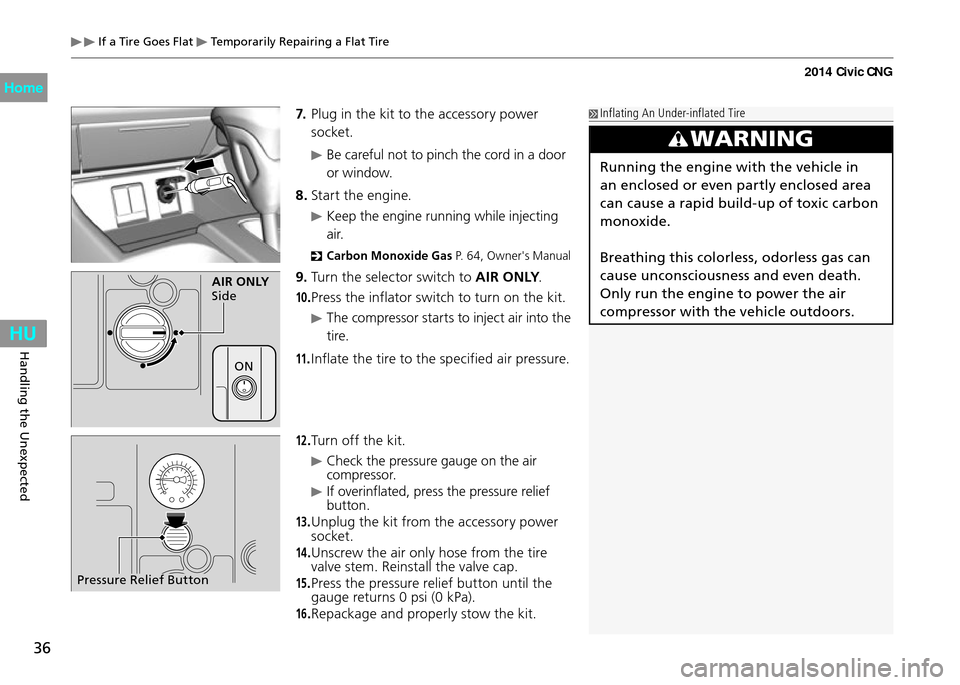
36
Handling the Unexpected
If a Tire Goes Flat Temporarily Repairing a Flat Tire
7. Plug in the kit to the accessory power
socket.
Be careful not to pinch the cord in a door
or window.
8. Start the engine.
Keep the engine running while injecting
a i r.
Carbon Monoxide Ga s
P. 64, Owner's Manual
9. Turn the selector switch to AIR ONLY .
10. Press the inflator switch to turn on the kit.
The compressor starts to inject air into the
tire.
11. Inflate the tire to the specified air pressure.
12. Turn off the kit.
Check the pressure gauge on the air
compressor.
If overinflated, press the pressure relief
button.
13. Unplug the kit from the accessory power
socket.
14. Unscrew the air only hose from the tire
valve stem. Reinstall the valve cap.
15. Press the pressure relief button until the
gauge returns 0 psi (0 kPa).
16. Repackage and properly stow the kit.
Inflating An Under-inflated Tire
AIR ONLY
Side
Pressure Relief Button
WARNING
Running the engine with the vehicle in
an enclosed or even partly enclosed area
can cause a rapid build-up of toxic carbon
monoxide.
Breathing this colorless, odorless gas can
cause unconsciousness and even death.
Only run the engine to power the air
compressor with the vehicle outdoors.
ON
2014 Civic CNG
Page 38 of 46
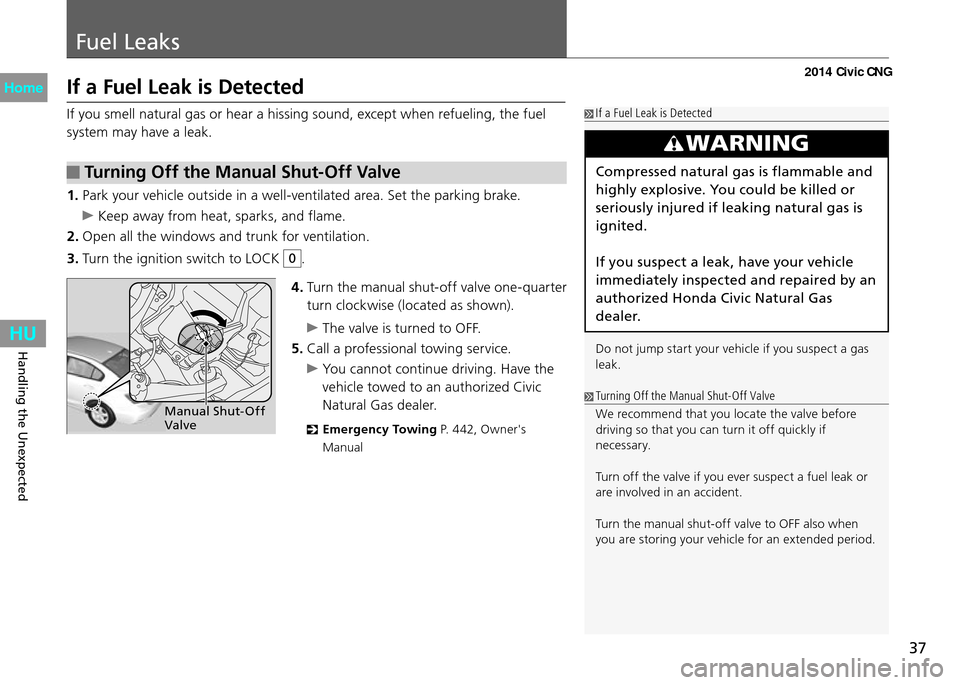
37
Fuel Leaks
Handling the Unexpected
If a Fuel Leak is Detected
If you smell natural gas or hear a hissing sound, except when refueling, the fuel
system may have a leak. If a Fuel Leak is Detected
WARNING
Compressed natural gas is flammable and
highly explosive. You could be killed or
seriously injured if leaking natural gas is
ignited.
If you suspect a leak, have your vehicle
immediately inspected and repaired by an
authorized Honda Civic Natural Gas
d e a l e r.
Do not jump start your vehicle if you suspect a gas
leak.
Turning Off the Manual Shut-Off Valve
We recommend that you locate the valve before
driving so that you can turn it off quickly if
ne ce s s ar y.
Turn off the valve if you ever suspect a fuel leak or
are involved in an accident.
Turn the manual shut-off valve to OFF also when
you are storing your vehicle for an extended period.
Turning Off the Manual Shut-Off Valve
4. Turn the manual shut-off valve one-quarter
turn clockwise (located as shown).
The valve is turned to OFF.
5. Call a professional towing service.
You cannot continue driving. Have the
vehicle towed to an authorized Civic
Natural Gas dealer.
Emergency Towing
P. 442, Owner's
Manual
1. Park your vehicle outside in a well-ventilated area. Set the parking brake.
Keep away from heat, sparks, and flame.
2. Open all the windows and trunk for ventilation.
3. Turn the ignition switch to LOCK
0.
Manual Shut-Off
Valve
2014 Civic CNG
Page 39 of 46
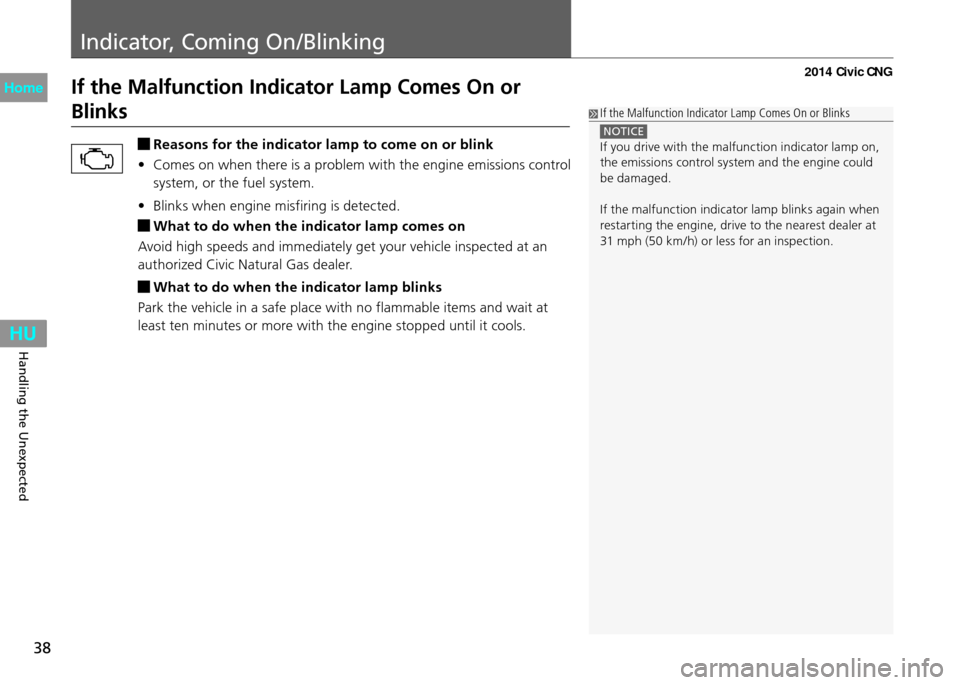
Indicator, Coming On/Blinking
38
Handling the Unexpected
If the Malfunction Indicator Lamp Comes On or
Blinks
If the Malfunction Indicator Lamp Comes On or Blinks
NOTICE
If you drive with the malfunction indicator lamp on,
the emissions control system and the engine could
be damaged.
If the malfunction indicator lamp blinks again when
restarting the engine, drive to the nearest dealer at
31 mph (50 km/h) or less for an inspection. Reasons for the indicator lamp to come on or blink
Comes on when there is a problem with the engine emissions control
•
system, or the fuel system.
Blinks when engine misfiring is detected.
•
What to do when the indicator lamp comes on
Avoid high speeds and immediately get your vehicle inspected at an
authorized Civic Natural Gas dealer.
What to do when the indicator lamp blinks
Park the vehicle in a safe place with no flammable items and wait at
least ten minutes or more with the engine stopped until it cools.
2014 Civic CNG
Page 40 of 46
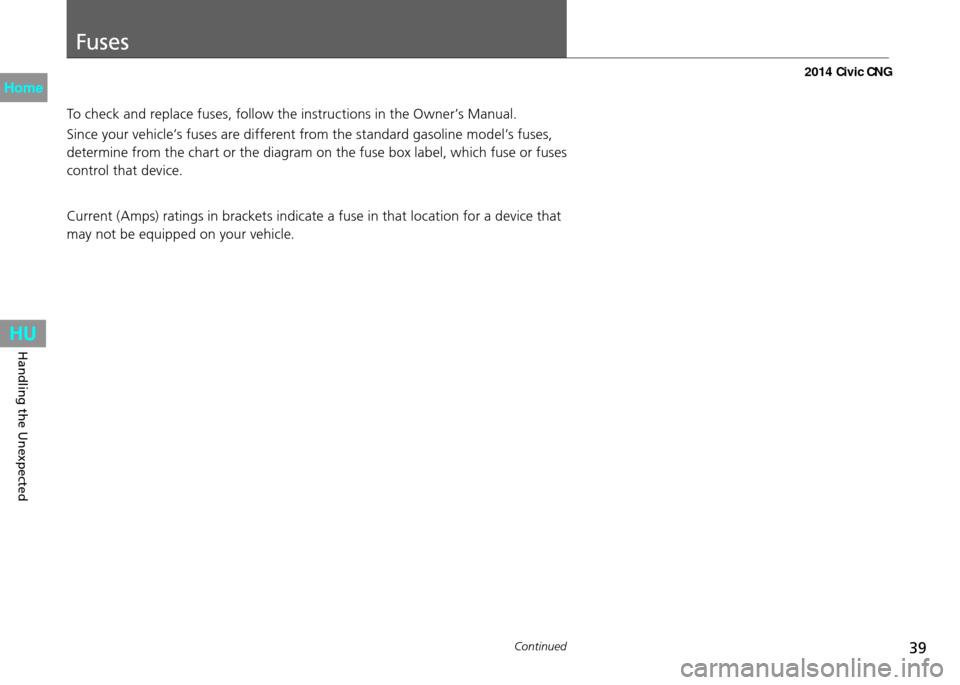
39
Fuses
Continued
Handling the Unexpected
To check and replace fuses, follow the instructions in the Owner’s Manual.
Since your vehicle’s fuses are different from the standard gasoline model’s fuses,
determine from the chart or the diagram on the fuse box label, which fuse or fuses
control that device.
Current (Amps) ratings in brackets indicate a fuse in that location for a device that
may not be equipped on your vehicle.
2014 Civic CNG